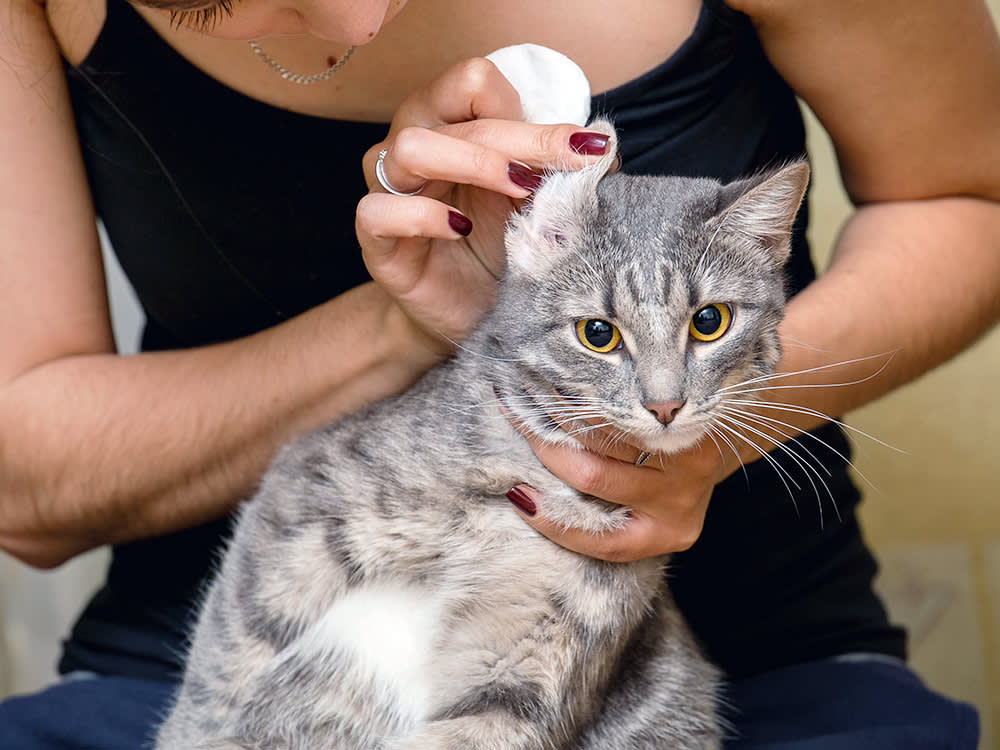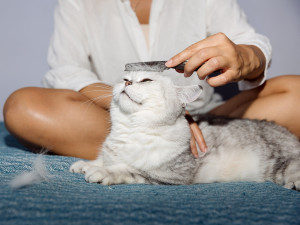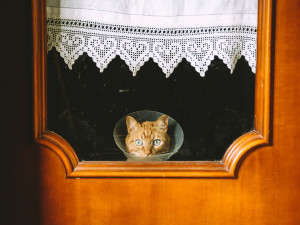Ear Mites in Cats: When to Worry and Preventative Measures
Uh, ew. But also: Here‘s what you should look out for.

Share Article
In This Article:
Symptoms of Ear Mite Infestation How Do Cats Contract Ear Mites? Consequences If Left Untreated How Do Vets Treat Ear Mites? Alternative Home Remedies for Ear Mites in Cats Frequently Asked Questions
Ear mites are highly contagious parasites that usually infest a cat’s ear canals, laying eggs and causing inflammatory discharge and crusty buildup. Treating ear mites requires vet-prescribed ear drops used for the full duration of the mite life cycle to exterminate them.
Symptoms of ear mite infestation
Thump thump thump. Thumpthumpthumpthump. Every cat parent knows the sound of their cat scratching their ears, especially if they’re doing it on your bed... while you’re trying to sleep. An occasional scratch is normal, but frequent or persistent scratching should raise some concerns about what’s going on in your cat’s ears.
Lots of things can make your cat scratch their ears, but ear mites are one of the most common (and itchy) causes of ear irritation in cats. Some common symptoms of ear mites in cats include:

Scratching at the ears
Once they colonize a cat’s ears, ear mites cause inflammation and irritation of the canals. The itchiness may come from movement of the mites themselves, increased sensitivity of the ears due to inflammation, or discharge clogging up the ears. Some cats are so itchy that they’ll show signs of a pinnal-pedal reflex — reflexively scratching at their ear with a back leg as soon as the ear canal is massaged.
Increased ear discharge
The presence of ear mites causes the ears to become inflamed and produce additional discharge. The mites also produce debris as they feed and lay eggs that are cemented to the walls of the ear canal. All this extra inflammation and gunk can interfere with the ear’s normal protective mechanisms, resulting in secondary bacterial or yeast infections. These infections compound the issue, resulting in more discharge and irritation.
Head shaking
In addition to giving some relief to itchiness, head shakingopens in new tab serves to get rid of some of the debris that builds up in cats’ ears. Although it can show up in many ways, the discharge associated with ear mite infestations is often black debris resembling coffee grounds. Cats can fling this gross stuff pretty far with a good head shake.
Inflammation
The presence of ear mites and secondary infections can result in a lot of inflammation. This can make a cat’s ears appear reddened and thickened. Some cats will have extra irritation to the outside of their ears due to constant scratching.
Hair loss
Hair loss can occur around the ears if an ear mite infestation is overwhelming, and the mites begin to spread to the skin outside of the ear. Mites can also migrate to other areas of the body, especially around the tail base, and set up shop there. It’s not their preferred location, but they can still cause a lot of irritation, discomfort, and hair loss in other areas.
Many cat ear mite symptoms are shared with other ear problems, so it can be hard to know for sure that your cat has ear mites without confirming with your veterinarian. Other possible causes of these symptoms include:
Mange
Fly bites
Bacterial or yeast ear infections
What are ear mites in cats?
Otodectes cynotis is the ear mite of the cat (and dog). These tiny little eight-legged mites are highly contagious and don’t have a strong preference for whose ears they are living in. They’re easily passed between different species of animals and people. They feed on normal ear secretions and skin cells, and the irritation from their presence increases the amount of discharge, making it easier for their population to grow. Although they cause a lot of itchiness, ear mites do not burrow beneath the skin.
Ear mites’ life cycle is short at about three weeks. The mites can spend their entire life in a cat’s ear and do not need an external host or carrier to complete their life cycle. Fortunately, ear mites don’t survive well off their host, which limits their spread a bit.
How do cats contract ear mites?
Cats get ear mites from other animals with ear mites. Direct contact with an infested animal is the primary mode of ear mite transmission. About 10 percent of cats have ear mite infestations without obvious signs, so these cats can serve as silent carriers of the disease. Mother-to-kitten transmission is also common, and kittens tend to be affected by ear mites most frequently.
Cats kept strictly indoors and out of contact with outdoor pets have a very low risk of contracting ear mites. Ear mites are much more common in outdoor cats because they have more opportunities to interact with other animals.
How to check for ear mites in cats
You may be concerned if you see black stuff in your cat’s ears, but no mites are visible. Female ear mites, which are larger than males, can grow to almost half a millimeter in size. This means that they’re just barely visible to the naked eye. Don’t expect to see ear mites at home, though. With the amount of discharge and debris in your cat’s ears, it can be very hard to spot the minuscule mites.
If you’re concerned about ear mites, your veterinarian can help diagnose the problem. They can use a combination of visualization of the ear canal with an otoscope, collection of ear discharge with a swab or curette, and microscopic examination to try to identify the mites. Your vet can also check for a secondary bacterial or yeast infection while checking your cat’s ears out.
What happens if a feline ear mite infestation isn’t treated?
Cats suffering from a severe or prolonged infestation of ear mites can develop serious issues. In addition to wounds from self-trauma from scratching at their ears constantly, cats can get ear hematomas from trauma to their pinnae (the pointy parts of the ears). Ear hematomas occur due to rupture of blood vessels in the flaps of the ears from ear scratching or head shaking. This bleeding results in a marked thickening of the pinna and eventual scarring if untreated.
Cats can be so bothered by their infested and infected ears that they become emaciated due to a lack of appetite. Untreated ear mites in cats can result in ruptured eardrums and neurological signs like loss of balance or a head tilt. Knowing how to get rid of ear mites in cats can save your cat a lot of suffering.
How do vets treat ear mites?
Treatment for ear mites in cats is much easier than it used to be. Early methods involved cleaning the ears, then applying mineral oil frequently or using a product that contains low levels of a pesticide that can be toxic to cats. These methods were not very effective and carried some danger for cats being treated.
Newer ear mite treatments are safer and more effective. There are topical drops that can be put in the ears after cleaning. These drops are just applied twice, two weeks apart — no daily treatment needed. Many spot-on flea and tick products are also effective against ear mites. Depending on the severity of the condition, your veterinarian may recommend a combination of products to treat the active problem and prevent future reinfestation.
If a bacterial or yeast infection is found at the same time, an antibacterial or anti-fungal ear medication may be needed in addition to the mite treatment. The medications used for these infections are usually topical and may need to be applied daily.
Alternative home remedies for ear mites in cats
Natural remedies for ear mites in cats are less effective, speedy, and safe than veterinary care. Outdated home remedies like mineral oil treatment only serve to prolong your cat’s discomfort and may not get rid of the mites. It’s best to just take your cat to the vet for simple, effective treatment of ear mites. Your cat will thank you.
Environmental control
Even though ear mites don’t survive for long when separated from their host, it’s important to thoroughly clean your cat’s bedding, toys, and environment. Not only does this get rid of all the gross ear wax they spread around, it makes sure there are no mites around to re-infest your cat.
If you have a multi-pet household, it’s important to treat all animals in the house for ear mites if anyone is diagnosed. This includes cats, dogs, and ferrets. Ask your vet for advice if you have other species in your menagerie as well. Even if these other pets aren’t showing symptoms of ear mites, your vet will likely recommend they be treated because of the risk of a silent carrier spreading the mites back to your cat.
Humans can be infested with ear mites, but it is very uncommon for it to be a significant problem. Because people are not natural hosts for the mites, infestations tend to be transient. Cat ear mites can cause local irritation on people’s skin or in their ear canals. Practice good hygiene after handling your cat if they have ear mites.
FAQs (People also ask):
What do ear mites look like in cats?
Ear mites are tiny eight-legged arthropods. They’re very hard to see with the naked eye, but they tend to produce a characteristic ear discharge that looks a little like coffee grounds in infested cats.
Can I touch my cat with ear mites?
You can touch your cat with ear mites, but it’s a good idea to wash your hands and any areas your cat contacted after. This can help prevent spread to other pets or yourself.
Can humans get ear mites from cats?
Humans can get ear mites from cats, but this is uncommon. Humans are not a normal host for cat ear mites, but people can suffer localized irritation if they are exposed to ear mites. Practice good hygiene when handling a cat with ear mites.
References:
Ear Mites: Uncovering, Treating, and Preventing Infestationsopens in new tab
Ectoparasites of Free-Roaming Domestic Cats in the Central United Statesopens in new tab

Dr. Bartley Harrison, DVM
Dr. Bartley Harrison is a veterinarian with more than 19 years of experience. He has treated a variety of species in emergency and speciality practices for both large and small animals. His primary interests as a vet are emergency medicine and critical care.
Related articles
![Man holding his large gray cat.]()
Why Does My Cat Have Bald Spots?
It only makes them cuter, but you may need to address the cause for this condition.
![A white cat in a meadow with flowers and tall grass.]()
4 Best Flea and Tick Preventatives and Treatments to Protect Your Kitty
From collars to topicals to chews, here are the flea and tick preventatives we’re giving our cats this summer.
![Brown Labrador lifting front leg]()
How to Get a Head Start on Your Pet’s Health
Spot lumps, limps, and lethargy early on.
![French bulldog puppy looking scared at vet]()
10 Things to Ask at Your First Vet Visit
There are no stupid questions — well, when it comes to your dog’s health.
![cat with cone after vet visit]()
How Often Should You Take Your Cat to the Vet?
Get thy cat to a vet, even if it’s a struggle to get them out the door.









